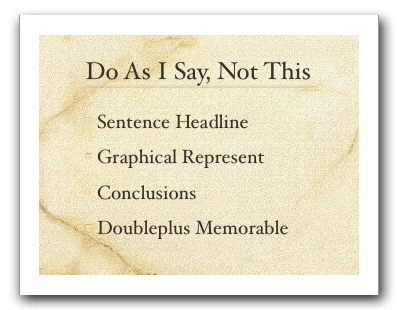Presentations and the Web
 It’s easy to put presentations on the web, just like it’s easy to create them. Neither is easy to do well. I’d like to talk not only about good slide creation, but how to distribute a presentation in a useful way. It’s not easy to create good presentations, even when you have good content. Simson Garfinkel pointed me to a great source on “The Design of Presentation Slides.” [link to http://www.writing.eng.vt.edu/slides.html no longer works] It’s based on actual research about presentation style and retention. It turns out that a full sentence headline, graphical representation of data, and conclusions to draw from the data presented is far more memorable than bulleted sentence fragments (right).
It’s easy to put presentations on the web, just like it’s easy to create them. Neither is easy to do well. I’d like to talk not only about good slide creation, but how to distribute a presentation in a useful way. It’s not easy to create good presentations, even when you have good content. Simson Garfinkel pointed me to a great source on “The Design of Presentation Slides.” [link to http://www.writing.eng.vt.edu/slides.html no longer works] It’s based on actual research about presentation style and retention. It turns out that a full sentence headline, graphical representation of data, and conclusions to draw from the data presented is far more memorable than bulleted sentence fragments (right).
This style also works well when the presentation is actually a presentation of some other organized thinking, such as a scientific paper, or progress report. When the presentation is accompaniment to something, I believe the research that says the headline sentence, data and conclusion style lead to better retention. What about when there is no other handout?
There’s an expectation that speakers at a conference or workshop will provide slides. From the perspective of the conference organizers, requesting slide offers some small assurance that the speaker has prepared, and allows the conference attendees to have the slides as a reminder of the talk. From the reminder perspective, outline slides are actually very useful. There’s rarely an expectation of handouts that aren’t the slides. Perhaps the most useful (generically) is an actual outline, created with a tool designed for that purpose. A real outline is useful because it is less constrained by the genre: ideas can be more than active fragments, and the printed page imposes fewer constraints on both sentence and block than the slide. An outline’s not so useful as data, but who has data these days?
So I think I may move away from my habit of providing multiple formats of the slides themselves, and move to putting up a three-part web page with outline, references, and any details of the argument that seem to require elucidation. Perhaps even a short essay.
I would do this because the two scenarios are so different: One involves having me at the front of a room, using slides to illustrate and orient around my words. The other, without me there, means that the message needs to be self-contained.